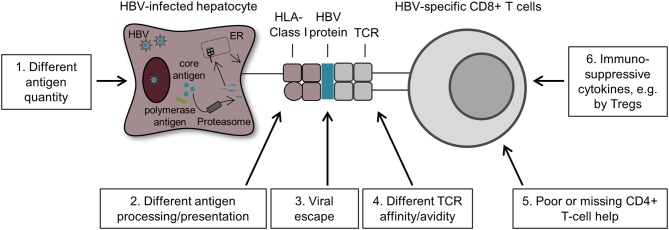Figure 3.
Possible mechanisms that drive HBV-specific CD8+ T-cell heterogeneity. First, HBV-infected hepatocytes produced varying amounts of HBV antigens resulting in different quantities of HBV peptide/HLA complexes on these cells. This difference may modulate the heterogeneity of HBV-specific CD8+ T cells targeting different antigens (1). Second, HBV antigen processing and presentation may also impact the phenotype and function of core18- and pol455-specific CD8+ T cells. In fact, HBV core antigens are secreted in high quantities by HBV-infected hepatocytes and are therefore more likely cross-presented by antigen-presenting cells, whereas the low amount of HBV polymerase antigens are primarily presented by HBV-infected hepatocytes (2). Third, the phenomenon of viral escape also affects antigen recognition by HBV-specific CD8+ T cells and thus may also contribute to HBV-specific CD8+ T-cell heterogeneity (3). Moreover, several other factors are also likely to promote HBV-specific CD8+ T-cell heterogeneity such as TCR affinity/avidity (4), a poor or missing CD4+ T-cell help (5) and the presence of immunosuppressive cytokines produced by Tregs and DCs (6).

